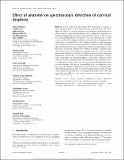Effect of anatomy on spectroscopic detection of cervical dysplasia
Author(s)
Mirkovic, Jelena; Lau, Condon; McGee, Sasha; Yu, Chung-Chieh; Nazemi, Jonathan H.; Galindo, Luis H.; Feng, Victoria; Darragh, Teresa; de las Morenas, Antonio; Crum, Christoper; Stier, Elizabeth; Feld, Michael S.; Badizadegan, Kamran; ... Show more Show less
DownloadFeld_Effect of Anatomy.PDF (177.0Kb)
PUBLISHER_POLICY
Publisher Policy
Article is made available in accordance with the publisher's policy and may be subject to US copyright law. Please refer to the publisher's site for terms of use.
Terms of use
Metadata
Show full item recordAbstract
It has long been speculated that underlying variations in tissue anatomy affect in vivo spectroscopic measurements. We investigate the effects of cervical anatomy on reflectance and fluorescence spectroscopy to guide the development of a diagnostic algorithm for identifying high-grade squamous intraepithelial lesions (HSILs) free of the confounding effects of anatomy. We use spectroscopy in both contact probe and imaging modes to study patients undergoing either colposcopy or treatment for HSIL. Physical models of light propagation in tissue are used to extract parameters related to tissue morphology and biochemistry. Our results show that the transformation zone, the area in which the vast majority of HSILs are found, is spectroscopically distinct from the adjacent squamous mucosa, and that these anatomical differences can directly influence spectroscopic diagnostic parameters. Specifically, we demonstrate that performance of diagnostic algorithms for identifying HSILs is artificially enhanced when clinically normal squamous sites are included in the statistical analysis of the spectroscopic data. We conclude that underlying differences in tissue anatomy can have a confounding effect on diagnostic spectroscopic parameters and that the common practice of including clinically normal squamous sites in cervical spectroscopy results in artificially improved performance in distinguishing HSILs from clinically suspicious non-HSILs.
Date issued
2009-09Department
Massachusetts Institute of Technology. Spectroscopy LaboratoryJournal
Journal of Biomedical Optics
Publisher
Society of Photo-Optical Instrumentation Engineers
Citation
Mirkovic, Jelena et al. “Effect of anatomy on spectroscopic detection of cervical dysplasia.” Journal of Biomedical Optics 14.4 (2009): 044021-8. ©2009 Society of Photo-Optical Instrumentation Engineers.
Version: Final published version
ISSN
1083-3668